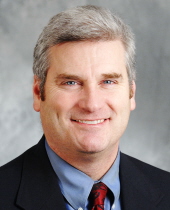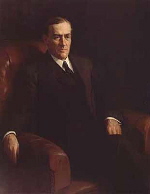Emmer Defeat During GOP Wave Would End Nearly 100-Year Trend in Minnesota Gubernatorial Elections
Minnesota has elected a GOP governor during every Republican wave dating back to 1916 (in 14 of 14 instances when GOP nets 15+ US House seats)

After all, Republican Governor Tim Pawlenty stunned much of the nation in 2006 (though not Smart Politics, which predicted his victory), when he won a second term in the face of a national and statewide Democratic wave.
And yet Emmer has seemingly yet to capitalize on the massive GOP momentum about to hit the nation this November.
RGA Chairman and Mississippi Governor Haley Barbour, Pawlenty, and New Jersey Governor Chris Christie are therefore going to give Emmer one final push, joining forces at an Emmer campaign event on October 30th, just three days before the election.
And just how remarkable would it be for a Republican to lose the state’s gubernatorial contest during a GOP wave?
Very.
So much so, in fact, that it would reverse a nearly century-long trend.
A Smart Politics analysis of historical election data finds that Minnesotans have elected a Republican governor during every GOP wave election dating back nearly 100 years to 1916.
In all 14 instances in which a Republican wave coincided with a gubernatorial election in the Gopher State during this 90+ year span, Minnesotans have elected a Republican into the governor’s office every time.
(Note: GOP waves are defined here as net gains of 15 or more seats in the U.S. House from the previous cycle. There were two additional GOP waves since 1916 in which Minnesota did not hold a gubernatorial election: in 1980, in which Republicans gained 34 House seats, and in 1984, when the GOP gained 16 seats).
The most recent instance of a GOP wave was, of course, the Republican Revolution of 1994, when the Party netted 52 seats in the U.S. House and Arne Carlson won his second term as governor of the Gopher State with 63.3 percent of the vote.
Minnesota Republican gubernatorial candidates have also ridden national GOP waves to knock out incumbents on three occasions: in 1938, when the GOP gained 81 seats in the House (defeating Farmer-Laborite Elmer Benson), in 1960, when Republicans won 21 seats (denying DFLer Orville Freeman a fourth term), and in 1966. when the Party notched 47 seats from the previous cycle (beating DFLer Karl Rolvaag).
In total, Republican gubernatorial candidates have taken home the top prize during 14 consecutive GOP waves: 1916 (+19 GOP seats, electing J.A.A. Burnquist), 1918 (+25, Burnquist), 1920 (+62, J.A.O. Preus), 1924 (+22, Theodore Christianson), 1928 (+32, Christianson), 1938 (+81, Harold Stassen), 1942 (+47 GOP, Stassen), 1946 (+55, Luther Youngdahl), 1950 (+28, Youngdahl), 1952 (+22, C. Elmer Anderson), 1960 (+21, Elmer Andersen), 1966 (+47, Harold LeVander), 1978 (+15, Al Quie), 1994 (+52, Arne Carlson).
Going back to 1886, when Minnesota’s gubernatorial election calendar switched from odd-numbered years to even-numbered years in step with federal elections, Republican candidates have been elected in the Gopher State during 17 of 19 GOP waves.

Republican candidates for governor in Minnesota have fared much less impressively absent a national wave – winning 16 contests and losing 15 since 1886 when Republican House gains were kept below 15 seats or Democrats were on the plus side.
During these past 130 years, GOP gubernatorial candidates have averaged just 45.5 percent of the vote when not riding a national Republican wave, compared to 52.7 percent when the Party gains at least 15 seats in the House.
Republicans also have enjoyed an average margin of victory (or margin of loss) of +14.4 points during GOP wave cycles, compared to an average -1.3-point margin during non-wave cycles, or a difference of 15.7 points.
Minnesota Republican Gubernatorial Success During GOP Waves, 1886-present
|
Election
|
Won
|
Lost
|
GOP %
|
Average MoV/MoL
|
|
GOP wave
|
17
|
2
|
52.7
|
+14.4
|
|
No GOP wave
|
16
|
15
|
45.5
|
-1.3
|
Republican waves are defined here as those election cycles in which the GOP netted at least 15 seats in the U.S. House. Minnesota did not hold gubernatorial elections during two GOP wave cycles (1980, 1984) and ten cycles without GOP waves (1964, 1968, 1972, 1976, 1988, 1992, 1996, 2000, 2004, 2008). Data compiled by Smart Politics.
As for Emmer, he has trailed DFLer Mark Dayton in five out of six polls conducted since the beginning of September.
And while Emmer does not have quite as large of a Republican base in Minnesota as other GOP gubernatorial candidates across the nation, that base should be more energized in 2010 than it was for Pawlenty in 2006 during a Democratic wave cycle.
As such, anything less than a victory and hold for the Republicans in the Gopher State on November 2nd will be seen as a missed opportunity by the RGA to keep the Democrats out of the state’s highest office for the beginning of the next quarter-century.
Republican Gubernatorial Success in Minnesota vis-à-vis Net Partisan Seat Change in the U.S. House, 1886-Present
|
Year
|
Winner
|
Percent
|
MoV
|
US House
|
|
2008
|
|
|
|
+21 Dem
|
|
2006
|
GOP (Pawlenty)
|
46.7
|
1.0
|
+31 Dem
|
|
2004
|
|
|
|
+3 GOP
|
|
2002
|
GOP (Pawlenty)
|
44.4
|
7.9
|
+8 GOP
|
|
2000
|
|
|
|
+1 Dem
|
|
1998
|
Reform (Ventura)
|
34.3
|
-2.7
|
+5 Dem
|
|
1996
|
|
|
|
+8 Dem
|
|
1994
|
GOP (Carlson)
|
63.3
|
29.2
|
+52 GOP
|
|
1992
|
|
|
|
+9 GOP
|
|
1990
|
GOP (Carlson)
|
50.1
|
3.3
|
+7 Dem
|
|
1988
|
|
|
|
+2 Dem
|
|
1986
|
DFL (Perpich)
|
43.1
|
-13.0
|
+5 Dem
|
|
1984
|
|
|
|
+16 GOP
|
|
1982
|
DFL (Perpich)
|
39.9
|
-18.9
|
+27 Dem
|
|
1980
|
|
|
|
+34 GOP
|
|
1978
|
GOP (Quie)
|
52.3
|
7.0
|
+15 GOP
|
|
1976
|
|
|
|
+1 Dem
|
|
1974
|
DFL (W. Anderson)
|
29.4
|
-33.4
|
+49 Dem
|
|
1972
|
|
|
|
+12 GOP
|
|
1970
|
DFL (W. Anderson)
|
45.5
|
-8.5
|
+12 Dem
|
|
1968
|
|
|
|
+5 GOP
|
|
1966
|
GOP (LeVander)
|
52.6
|
5.7
|
+47 GOP
|
|
1964
|
|
|
|
+36 Dem
|
|
1962
|
DFL (Rolvaag)
|
49.7
|
0.0
|
+2 GOP
|
|
1960
|
GOP (Andersen)
|
50.6
|
1.5
|
+21 GOP
|
|
1958
|
DFL (Freeman)
|
42.3
|
-14.5
|
+49 Dem
|
|
1956
|
DFL (Freeman)
|
48.2
|
-3.2
|
+2 Dem
|
|
1954
|
DFL (Freeman)
|
46.8
|
-5.9
|
+19 Dem
|
|
1952
|
GOP (C.E. Anderson)
|
55.3
|
11.3
|
+22 GOP
|
|
1950
|
GOP (Youngdahl)
|
60.7
|
22.4
|
+28 GOP
|
|
1948
|
GOP (Youngdahl)
|
53.1
|
8.0
|
+75 Dem
|
|
1946
|
GOP (Youngdahl)
|
59.0
|
19.3
|
+55 GOP
|
|
1944
|
GOP (Thye)
|
61.6
|
23.8
|
+20 Dem
|
|
1942
|
GOP (Stassen)
|
51.6
|
13.8
|
+47 GOP
|
|
1940
|
GOP (Stassen)
|
52.1
|
15.6
|
+5 Dem
|
|
1938
|
GOP (Stassen)
|
59.9
|
25.7
|
+81 GOP
|
|
1936
|
Farmer-Labor (Benson)
|
38.6
|
-22.1
|
+12 Dem
|
|
1934
|
Farmer-Labor (Olson)
|
37.7
|
-6.9
|
+9 Dem
|
|
1932
|
Farmer-Labor (Olson)
|
50.6
|
18.3
|
+97 Dem
|
|
1930
|
Farmer-Labor (Olson)
|
36.3
|
-23.0
|
+52 Dem
|
|
1928
|
GOP (Christianson)
|
55.0
|
32.3
|
+32 GOP
|
|
1926
|
GOP (Christianson)
|
56.5
|
18.4
|
+11 Dem
|
|
1924
|
GOP (Christianson)
|
48.7
|
4.9
|
+22 GOP
|
|
1922
|
GOP (Preus)
|
45.2
|
2.1
|
+76 Dem
|
|
1920
|
GOP (Preus)
|
53.1
|
17.2
|
+62 GOP
|
|
1918
|
GOP (Burnquist)
|
45.0
|
14.7
|
+25 GOP
|
|
1916
|
GOP (Burnquist)
|
62.9
|
39.1
|
+19 GOP
|
|
1914
|
Democrat (Hammond)
|
41.9
|
-3.6
|
+62 GOP
|
|
1912
|
GOP (Eberhart)
|
40.3
|
9.0
|
+61 Dem
|
|
1910
|
GOP (Eberhart)
|
55.7
|
20.5
|
+58 Dem
|
|
1908
|
Democrat (Johnson)
|
43.9
|
-8.0
|
+5 Dem
|
|
1906
|
Democrat (Johnson)
|
34.9
|
-26.0
|
+32 Dem
|
|
1904
|
Democrat (Johnson)
|
46.1
|
-2.6
|
+44 GOP
|
|
1902
|
GOP (Van Sant)
|
57.5
|
20.8
|
+25 Dem
|
|
1900
|
GOP (Van Sant)
|
48.7
|
0.7
|
+13 GOP
|
|
1898
|
Dem-People’s (Lind)
|
44.3
|
-8.0
|
+37 Dem
|
|
1896
|
GOP (Clough)
|
49.2
|
1.1
|
+31 Dem
|
|
1894
|
GOP (Nelson)
|
49.9
|
20.2
|
+130 GOP
|
|
1892
|
GOP (Nelson)
|
42.7
|
5.7
|
+38 GOP
|
|
1890
|
GOP (Merriam)
|
36.6
|
1.0
|
+86 Dem
|
|
1888
|
GOP (Merriam)
|
51.4
|
9.3
|
+27 GOP
|
|
1886
|
GOP (McGill)
|
48.5
|
1.1
|
+11 GOP
|
Note: Prior to 1886, Minnesota held gubernatorial elections during odd-numbered years. Prior to the 1990s, partisan change in far right column reflects November-to-November Election Day changes in seats gained (Source: Office of the Clerk of U.S. Representatives). Table compiled by Smart Politics.
Follow Smart Politics on Twitter.

OK, by the aforementioned definition, the 2014 cycle does not qualify as a “wave” cycle for the Rs, for they posted a net gain of less than 15 House seats (regardless of how the party fared at any other level). Of course, with IRV, the DFLers might have won in 2006 and 2002, and the Rs might have won in 2010 – thus aligning the state’s gubernatorial contests with the national results in those respective years. The state would at last follow the national currents in the 2018 election for governor/lieutenant governor.